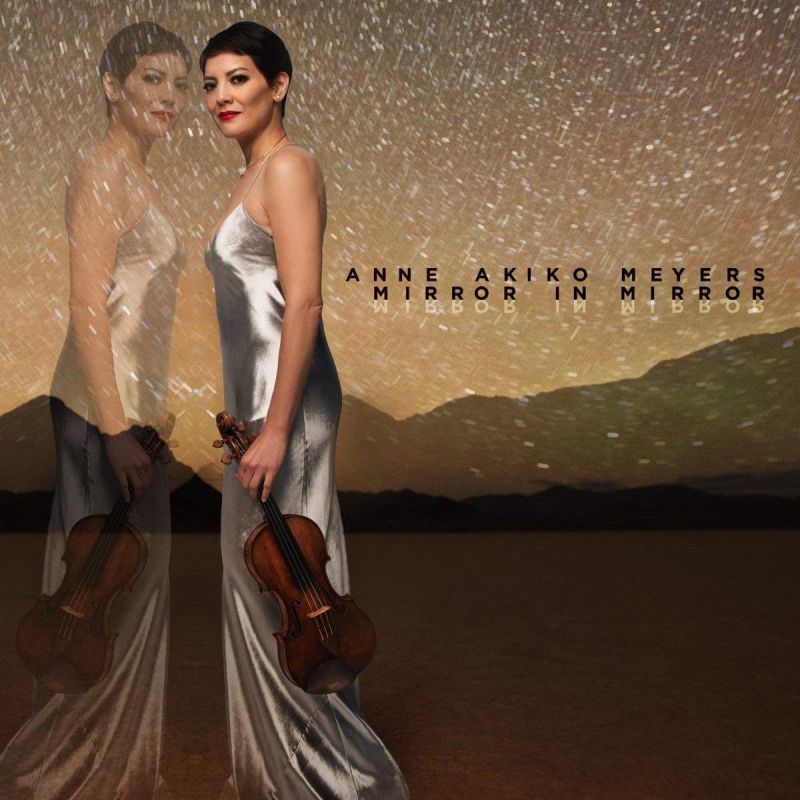Anne Akiko Meyers: Mirror in Mirror
View record and artist detailsRecord and Artist Details
Composer or Director: Jakub Ciupinski, Philip Glass, Maurice Ravel, Arvo Pärt, Morten Lauridsen
Genre:
Orchestral
Label: Avie
Magazine Review Date: 10/2018
Media Format: CD or Download
Media Runtime: 64
Mastering:
DDD
Catalogue Number: AV2386

Tracks:
| Composition | Artist Credit |
|---|---|
| Metamorphosis II |
Philip Glass, Composer
Akira Eguchi, Piano Anne Akiko Meyers, Violin Philip Glass, Composer |
| Fratres |
Arvo Pärt, Composer
Akira Eguchi, Piano Anne Akiko Meyers, Violin Arvo Pärt, Composer |
| Spiegel im Spiegel |
Arvo Pärt, Composer
Akira Eguchi, Piano Anne Akiko Meyers, Violin Arvo Pärt, Composer |
| Tzigane |
Maurice Ravel, Composer
Anne Akiko Meyers, Violin Elizabeth Pridgen, Keyboard Jakub Ciupinski, Composer Maurice Ravel, Composer |
| Edo Lullaby |
Jakub Ciupinski, Composer
Anne Akiko Meyers, Violin Jakub Ciupinski, Composer |
| Wreck of the Umbria |
Jakub Ciupinski, Composer
Anne Akiko Meyers, Violin Jakub Ciupinski, Composer |
| O Magnum Mysterium |
Morten Lauridsen, Composer
Anne Akiko Meyers, Violin Kristjan Järvi, Conductor Morten Lauridsen, Composer Philharmonia Orchestra |
Author: Andrew Mellor
Meyers has recorded the piece before but here we have a version featuring Jakub Ciupiński’s digital re-creation of the luthéal, the piano add-on Ravel indicated might be used. That sounds convincing and fascinating, but Meyers’s own gypsy fire doesn’t have the abandon of some of her recent rivals, Patricia Kopatchinskaja included (Alpha, 2/18).
I would have ditched Tzigane altogether, because Meyers’s stern, highly controlled but variously coloured sound meets every other piece here very well indeed. Her rapid arpeggio figurations across the four strings of the 1741 ex-Vieuxtemps Guarneri del Gesù are firm and consistent, her tone strong without being sweet or glossy. It works a treat in Glass’s Metamorphosis II (the arrangement is by Michael Riesman) and for the ritornellos in Pärt’s Fratres. Meyers adopts a fixed colour for each phase of the latter, each holding you in its gaze. From the figurations at 6'00" she strikes every note bang in its centre point. Each bow stroke has the same, consistent level of intensity.
That said, Corigliano’s Lullaby, written for Meyer’s baby daughter, might have benefited from less contact and a more innocent sound. It’s a pretty piece but the two original scores by Ciupiński are more worthy successors to Pärt’s, each disciplined and fertile. Initially, Lauridsen’s own concertante arrangement of O magnum mysterium reveals how much the piece owes to the open-prairie sound of Copland and others, but the cymbal-strewn anti-crescendos are straight out of the Hollywood cheesemonger’s toolkit and the piece becomes something more sickly than a ‘quiet song of profound inner joy’ (the composer’s description of the original motet). Maybe that’s OK given the market. And, frankly, I struggle more with the shock of Tzigane.
Discover the world's largest classical music catalogue with Presto Music.

Gramophone Digital Club
- Digital Edition
- Digital Archive
- Reviews Database
- Full website access
From £8.75 / month
Subscribe
Gramophone Full Club
- Print Edition
- Digital Edition
- Digital Archive
- Reviews Database
- Full website access
From £11.00 / month
Subscribe
If you are a library, university or other organisation that would be interested in an institutional subscription to Gramophone please click here for further information.




